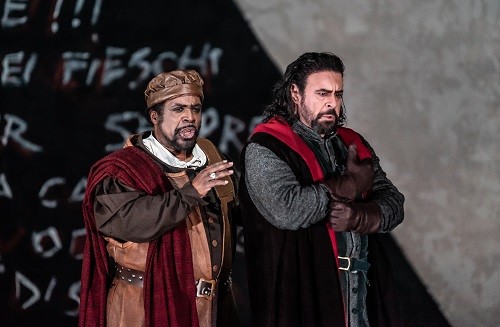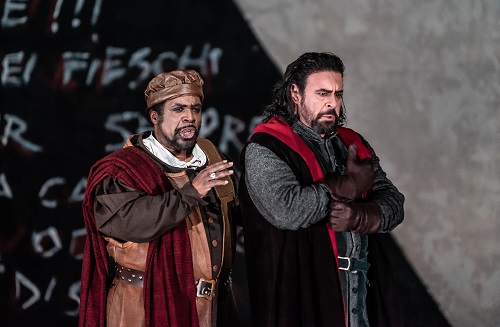 United Kingdom Verdi, Simon Boccanegra: Soloists, Chorus and Orchestra of the Royal Opera House / Henrik Nánási (conductor). Royal Opera House, Covent Garden, London 15.11.2018. (JPr)
United Kingdom Verdi, Simon Boccanegra: Soloists, Chorus and Orchestra of the Royal Opera House / Henrik Nánási (conductor). Royal Opera House, Covent Garden, London 15.11.2018. (JPr)

Production:
Director – Elijah Moshinsky
Set designer – Michael Yeargan
Costume designer – Peter J. Hall
Lighting designer – John Harrison
Fight director – Philip d’Orléans
Cast:
Simon Boccanegra – Carlos Álvarez
Jacopo Fiesco – Ferruccio Furlanetto
Amelia Grimaldi – Hrachuhi Bassenz
Gabriele Adorno – Francesco Meli
Paolo Albiani – Mark Rucker
Pietro – Simon Shibambu
Simon Boccanegra is set in Genoa, Italy’s greatest seaport on the Ligurian Sea with a venerable history and still today an important place where goods are shipped to Northern Italy and then on to Central Europe. When Simone Boccanegra was its first Doge, Genoa competed with other Italian city-states for dominion over trade routes. The sea is crucial as a background to the story and Verdi tells us as much in the score, particularly in his 1881 revised version.
The 1857 first version was a disaster for the composer and so more than twenty years later there was a second ‘world première’ for the opera. Verdi’s original librettist Piave was long dead, so he turned to Arrigo Boito who later helped him create the masterpieces Otello and Falstaff that were to follow. Even Boito did not pull his punches over the difficulties explaining to Verdi how ‘Our task, my Maestro, is arduous. The drama that we are working with is lopsided like a table that wobbles, but no one knows which leg is the cause, and whatever is done to steady it, it still wobbles. I don’t find in this drama a single character of which one can say: it’s sharply delineated! No event that is really fatal, that is indispensable and potent, generated by tragic inevitability. I make an exception of the prologue, which is truly beautiful …’.
The 1881 version of Boccanegra has a simple Prelude with a theme that gently imitates the sea, something that – as suggested above – permeates the atmosphere of the entire work. Elsewhere the depiction of the sea is even clearer. At the opening of Act III a surging orchestra – under the impressive baton of Henrik Nánási – creates the aural equivalent of turbulent waves, matching not only a storm brewing in the port but also the psychological tension of the drama. Verdi will employ this duality again in Otello. More gentle waves, sea breezes, and even some birdcalls are heard at the opening of Boccanegra Act I which moves the story on 25 years from the time of the Prologue to reveal a palace garden that should have an outlook over the water. Here Amelia Grimaldi reflects on her love for the young patrician, Gabriele Adorno in a gorgeous evocation of nature. Later in Act III, when the dying Doge is in his palace reminiscing about the sea and his past triumphs, Verdi’s musical accompaniment seems to evoke a breeze from the Gulf of Genoa. All this showcases the familiar operatic (Verdian?) tropes of hidden or mistaken identities, a father and daughter separated then reunited, love either filial or sexual, lust for power, betrayal etc. etc.
My history with Simon Boccanegra in the Royal Opera House does not go back as far as Tito Gobbi’s famous 1965 production that allowed Covent Garden audiences to hear the opera for the first time. My first one was in 1976 when Claudio Abbado conducted his La Scala company. Then I saw Filippo Sanjust’s 1980 production with Sherrill Milnes and Kiri Te Kanawa before others including this Elijah Moshinsky 1991 Boccanegra that I last saw in 2010 with Plácido Domingo singing Boccanegra.
Moshinsky apparently returned to oversee this seventh revival of his staging. Michael Yeargan’s virtually permanent single set has a perspective of high columns receding to the back of the stage inspired by a fifteenth-century painting The Ideal City and atmospherically lit by John Harrison. We do not see much more apart from a few tables and benches (only really there to be thrown over in the riot), a few odds and ends for Boccanegra’s study and the all-important water glass and jug so we can see Paolo poison the Doge’s drinking water. There are also three walls that are dropped in with either gold lettering or graffiti and we need little else to complete the mise-en-scène for this convincing staging other than the late Peter J. Hall’s resplendent period costumes and some appropriate weaponry and armoury. It works because Moshinsky’s direction puts all the leading singers in the best positions on stage to sing out to the audience and they can be heard clearly because of the ceiling the original conductor, Georg Solti, demanded was in Yeargan’s set. To be honest this Boccanegra – with only minimal alterations – could be adapted for any number of operas with a Renaissance period setting, or similar.
The journey Simon Boccanegra makes in this opera from virile buccaneer to greying, aged, imperious ruler – due to the 25-year fast-forward between the Prologue and Act I – falls several years short of my association with the opera that is now well over 42 years! I am intrigued why after several false starts in the early years I am now really beginning to enjoy Simon Boccanegra. Rarely has a Verdi opera – and Boccanegra particularly – flown by so quickly. It might not have been for everyone, but this was an old-fashioned night at the opera; big performances, can belto singing from the principals given excellent support by a chorus on great form and the orchestra – seemingly happy to be playing Verdi after all the recent Wagner – under Nánási. He led all concerned with an ideal combination of drive, passion, heightened emotion and energy – allied to orchestral virtuosity – that is heard too rarely at Covent Garden these days, whatever the opera.
Carlos Álvarez overcame splendidly the difficult task of going from adventurer and young lover to a patriarch mired in the political intrigues of fourteenth-century Genoa yet remaining dedicated to resolving long-standing feuds and reuniting all the warring factions. As the latter he exuded great authority and showed considerable stage presence and his curse in the Act I council chamber scene had a chilling impact. His character has no aria in a conventional sense, but every note he sings needs to reflect the hard-won wisdom of the pater familias. We must experience the pain of his enforced separation from his child (who was abducted under mysterious circumstances), the joy of their reunion and then the anguish of his long slow death by poison. Álvarez was an imperious Boccanegra; his voice had lyric expansiveness when necessary and mostly it had grandeur and stentorian power.
The great Italian bass Ferruccio Furlanetto seems a fixture in this opera at Covent Garden as Boccanegra’s implacable nemesis Fiesco and is now almost 70. After a few vocal issues early on he proved once again how ‘age is just a number’ and brought gravitas and considerable dignity to Fiesco. As Gabriele Adorno, Amelia’s jealous lover, Francesco Meli, was full-throated and ardent and his Act I off-stage serenade bought to mind his infamous compatriot, the late Franco Bonisolli, who I heard sing this role in 1982 at Covent Garden with much the same unrelentingly volume. I relished this similarly all guns blazing approach and to his credit Meli was able to pare back his voice when required and bought much more nuance to Adorno than Bonisolli ever did in this or anything he sang. I had a few doubts about Hrachuhi Bassenz’s Amelia as her sound was steelier than the slender, limpid soprano, the role probably requires though the trills in her pleas for peace were confidently accomplished. Another veteran, Mark Rucker, was a fine Paolo Albiani, the opera’s double-crossing villain. He sounded a genuine Verdi baritone and it should not have taken him so long to make his Royal Opera debut. As Pietro, Paolo’s right-hand man, Simon Shibambu’s resonant tones made another strong impression and Simon Davies stepped out of the chorus for a brief moment in the spotlight as an eloquent sounding Captain.
Viva Verdi!
Jim Pritchard
For more about what is on at the Royal Opera House click here.
